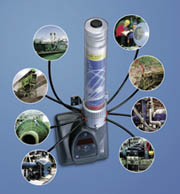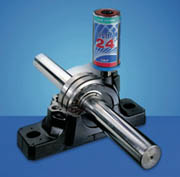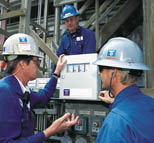
Hardig isn't suggesting leaner maintenance budgets or a run-to-failure approach to operations, though for noncritical pieces of equipment, that's not a bad tactic. Instead, he believes the way maintenance resources are deployed is often the problem.
By adopting a reliability-centered maintenance (RCM) strategy, maintenance managers can eliminate unnecessary work and focus on projects that optimize throughput in their plants.
Hardig is strategic account manager of the food & beverage group at SKF Reliability Systems in Cincinnati, OH. It's a US arm of Swedish bearings manufacturer SKF Group. Precision bearings and seals are favored by power plants and automakers-think Volvo-but Asian suppliers are making bearings and seals that are not far behind world-class quality. Rather than become a commodity supplier, SKF is remaking itself as a lifecycle-management service provider, offering its expertise in lubrication, root-cause analysis and other maintenance metrics to a broader range of industries. Instead of relying on distributors as the contact point with food and beverage processors, SKF specialists are spreading the RCM gospel now.
They're not the only evangelists knocking on maintenance department doors. Rockwell Automation is moving aggressively into the same service space, extending the concept to include on-site management of parts inventories. Cataloging parts and tracking when and where they went into service and when they are replaced is a tedious task. It also is essential data gathering for the software programs that promise maintenance efficiencies through automation. A computerized maintenance management system (CMMS) can save 20 percent or more, suggests Mark Himes, a member of the parts management team at Rockwell, with a big chunk of savings coming from improved warranty tracking. For many plants, maintaining a record of in-service dates for parts is the Achilles heel of maintenance programs, and they are leaving serious dollars on the parts table as a result.

Vibration sensors and other self-diagnostic tools are incorporated in many plant assets, particularly specialty instruments such as scales, points out Brian O'Rourke, customer service director at San Diego's Hardy Instruments Inc. Unfortunately, "a lot of food and beverage companies are cutting back on their maintenance staffs," and information from on-board diagnostic tools goes to waste, O'Rourke says. Hardy recently launched an outsourced maintenance program through a network of service technicians to help plants leverage scale data for predictive maintenance.

Alphabet-soup solutions
Aside from the military, maintenance automation specialists coin more acronyms and initializations than any other living group. MTTF (mean time to failure), OEE (overall equipment effectiveness), EAM (enterprise asset management) and AEO (asset efficiency optimization) are terms that trip off their tongues. SKF chips in with RCM, though CMMS is a tag it would just as soon avoid. SKF is taking more of a machine-level approach to maintenance. "We help populate CMMS with tools like root-failure analysis," says Hardig, but IT-based solutions are not the place to start. "The technology piece of maintenance is the easy part," he says. "The biggest challenge is changing the company culture."Operator-driven reliability is one aspect of culture change. Changes in Delta pressure, the conditions of coils in a heat exchanger, the presence of metal shavings at a friction point are readily observable events. "Operator rounds could be done on every shift, with predetermined tasks and observations entered into a database with predetermined alarm sets," Hardig says. Operator involvement may be less sophisticated than predictive maintenance, but it can be more effective. It also is more efficient than preventive maintenance, most of which is wasted effort, he suggests.

A study by the Engineering Research Center in the Netherlands drives the last point home. Improper lubrication was implicated in 36 percent of bearing failures. Over-lubrication was as much a factor as under-greasing. It causes blown seals, excessive operating temperatures and premature part wear due to excessive resistance. Taking both the grease gun and the grease-gun operator out of the equation is one way to address misapplication problems. SKF's solution is System 24, an automatic lubricator that uses hydrogen gas cells to propel grease or oil to as many as eight lubrication spots on a preset rate. A multi-point system with eight 16-ft. feed lines also has been developed.
Asset optimization reviews by Rockwell technicians differ from SKF's in that lubrication and other basics of mechanical operations are not the focus. MRO for electronic infrastructures and repairable parts is emphasized, with maintenance procedures and inventory management often supported by RAAMP (Rockwell Automation asset management program). RAAMP is a database program for tracking replacement parts and other assets with assigned bar codes. Assigning the codes and ensuring parts are scanned in and out is thankless work, Rockwell's Himes allows. Some large food and beverage facilities opt to have a Rockwell asset management professional on site to catalog information and maintain database integrity. Pilot programs in which RFID tags replace bar codes are underway to refine the parts-tracking challenge. "Long term, people want to know, ‘Where is this part in my facility now?'" says Himes. Answering the question via radio frequency instead of scrambling over machinery to scan bar codes has obvious appeal.
Some food plants aren't content to outsource the management of parts supplies; they're asking companies like Rockwell to take ownership of the entire inventory. Carrying costs, obsolescence costs, warranty recoveries and the challenge of having adequate replacement inventories without overstocking become the responsibility of a third party with the expertise, manpower and time to make sure it is done correctly.
In that scenario, Rockwell becomes the storeroom for many electrical and electronic parts. For high turn, low-cost inventory, parts might be carried by the more than 500 local distributors Rockwell works with nationwide. In many cases, those distributors rely on PTplace.com, an e-commerce and logistics site where they can comparison shop for parts from Rockwell, SKF, the Timken Co., Barden Precision Bearings, FAG and other suppliers. PTplace.com is jointly owned by participating manufacturers. It operates seven parts distribution centers across the country to ensure expedited delivery of replacement parts when needed.
As ingredients and products move from point to point, changes in weight become a useful indicator of process control. As a result, precision scales and check-weighers have proliferated in food plants. Knowing which replacement parts to order and when is a challenge with load cells and other precision instruments. To simplify the task, scale manufacturers are producing instruments with sophisticated diagnostics.
Mettler Toledo offers TraxEMT (embedded maintenance technician) on its most advanced scale terminal. EMT schedules and tracks the terminal's maintenance, maintains ISO calibration and predicts failures. Some maintenance can be performed through an Internet portal, while an alarm sounds or an email is sent for tasks requiring human intervention.
Hardy Instruments offers similar support with Integrated Technician, a continuous monitoring system that troubleshoots and diagnoses many weigh-system problems. Automation has its limitations, however, which is why Hardy is rolling out its Service by Design program.
"I have seen load-cell cables that have been eaten away by rodents in food plants and piping that has been attached to chocolate kettles that affected scale readings," Hardy's O'Rourke says. "Human intervention sometimes causes problems." In that event, human intervention is needed to resolve them, which is the idea behind Service by Design. Hardy has provided specialized training to more than 200 field technicians with a service firm O'Rourke declined to name. When maintenance issues beyond the scope of remote diagnostics surface, Hardy will dispatch a technician to the plant, anytime of day. Pilot programs were performed in California and Pennsylvania earlier this year.
Whether it's a drive shaft experiencing excessive vibration or a refrigeration system demanding more coolant, plant machinery is sending signals about its maintenance needs. Automation is providing listening posts to interpret those signals and ease the human burden in maintenance.
For more information:
Marty Osborn, Datastream,
864-414-4692
Brian O'Rourke, Hardy Instruments,
858-292-2710, ext. 1125
Mark Himes, Rockwell Automation,
414-382-5464
Kevin Hardig, SKF Reliability Systems,
513-941-8254,
Kevin.g.hardig@skf.com